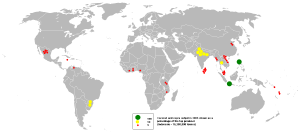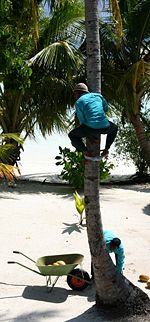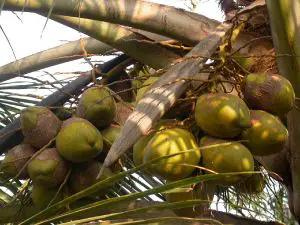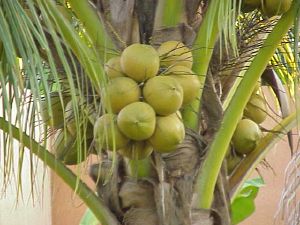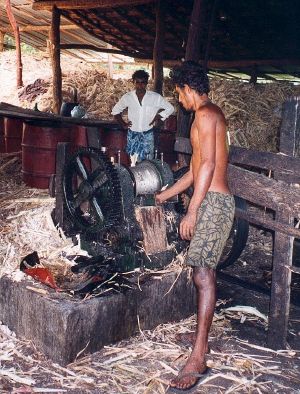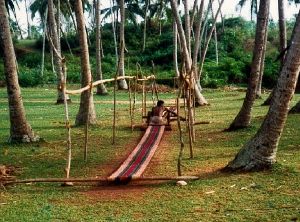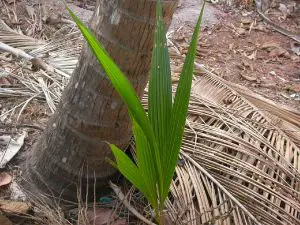Difference between revisions of "Coconut" - New World Encyclopedia
Katya Swarts (talk | contribs) (Fixed taxobox) |
Rick Swarts (talk | contribs) |
||
| Line 1: | Line 1: | ||
| − | {{ | + | {{Claimed}} |
| − | {{ | + | {{Taxobox |
| − | + | | color = lightgreen | |
| − | + | | name = Coconut | |
| − | + | | status = | |
| − | |||
| − | |||
| − | |||
| − | |||
| − | |||
| − | |||
| − | |||
| − | |||
| − | The '''Coconut Palm''' (''Cocos nucifera'') | + | secure |
| + | | image = Koeh-187.jpg | ||
| + | | image_caption = Coconut Palm (''Cocos nucifera'') | ||
| + | | regnum = [[Plant]]ae | ||
| + | | divisio = [[Flowering plant|Magnoliophyta]] | ||
| + | | classis = [[Liliopsida]] | ||
| + | | ordo = [[Arecales]] | ||
| + | | familia = [[Arecaceae]] | ||
| + | | genus = '''''Cocos''''' | ||
| + | | species = '''''C. nucifera''''' | ||
| + | | binomial = ''Cocos nucifera'' | ||
| + | | binomial_authority = [[Carolus Linnaeus|L.]] | ||
| + | }} | ||
| + | {{otheruses}} | ||
| + | The '''Coconut Palm''' (''Cocos nucifera'') is a member of the Family [[Arecaceae]] (palm family). It is the only species in the [[genus]] ''Cocos'', and is a large palm, growing to 30 m tall, with [[pinnate]] [[leaf|leaves]] 4-6 m long, pinnae 60-90 cm long; old leaves break away cleanly leaving the trunk smooth. The term ''coconut'' refers to the fruit of the coconut palm. | ||
| − | + | The coconut palm is grown throughout the tropical world, for decoration as well as for its many culinary and non-culinary uses; virtually every part of the coconut palm has some human use. | |
| − | |||
| − | |||
| − | The coconut palm thrives on sandy soils and is highly tolerant of salinity | + | == Origins and cultivation == |
| + | [[Image:2005coconut_and_copra.PNG|thumb|right|Coconut and copra output in 2005]] | ||
| + | [[Image:coconut_harvest.jpg|thumb|A man climbing a palm to harvest coconuts. Behind the palm a young plant is visible.|150px]] | ||
| + | The origins of this plant are the subject of controversy, with some authorities claiming it is native to south [[Asia]], while others claim its origin is in northwestern [[South America]]. Fossil records from [[New Zealand]] indicate that small, coconut-like plants grew there as long as 15 million years ago. Even older fossils have been uncovered in [[Rajasthan]], [[TamilNadu]], [[Kerala]] and [[Maharashtra]], [[India]]. Regardless of its origin, the coconut has spread across much of the tropics, probably aided in many cases by sea-faring peoples. The fruit is light and buoyant and presumably spread significant distances by marine currents. Fruits collected from the sea as far north as Norway have been found to be viable (and subsequently germinated under the right conditions). In the [[Hawaiian Islands]], the coconut is regarded as a [[Polynesia]]n introduction, first brought to the islands by early Polynesian voyagers from their homelands in the [[Oceania|South Pacific]]. They are now ubiquitous to most of the planet between 26ºN and 26ºS. | ||
| + | The coconut palm thrives on sandy soils and is highly tolerant of salinity. It prefers areas with abundant sunlight and regular rainfall (750 to 2,000 mm annually), which makes colonizing shorelines of the tropics relatively straightforward. Coconuts also need high humidity (70–80%+) for optimum growth, which is why they are rarely seen in areas with low humidity (e.g. the [[Mediterranean]]), even where temperatures are high enough (regularly above 24°C). They are very hard to establish in dry climates and cannot grow there without frequent irrigation. They may grow but not fruit properly in areas where there is not sufficient warmth, like Bermuda. | ||
| + | |||
| + | Coconut palms are intolerant of freezing weather. They will show leaf injury below 34ºF (1ºC), defoliate at 30ºF (-1ºC) and die at 27ºF (-3ºC). There are rare reports of coconut palms surviving (with severe damage) to 20ºF (-7ºC). One night of freezing weather can set the growth of a coconut palm back about 6 months. | ||
The flowers of the coconut palm are [[polygamomonoecious]], with both male and female flowers in the same inflorescence. Flowering occurs continuously, with female flowers producing seeds. Coconut palms are believed to be largely cross-[[pollination|pollinated]], although some dwarf varieties are self-pollinating. | The flowers of the coconut palm are [[polygamomonoecious]], with both male and female flowers in the same inflorescence. Flowering occurs continuously, with female flowers producing seeds. Coconut palms are believed to be largely cross-[[pollination|pollinated]], although some dwarf varieties are self-pollinating. | ||
| − | ==The fruit== | + | ===Growing in the United States=== |
| − | [[Image:Cocos nucifera14.jpg|thumb|left|Maturing Coconuts on the | + | The only two states in the U.S. where coconut palms can be grown and reproduce outdoors without irrigation are [[Hawaii]] and [[Florida]]. Coconut palms will grow from Bradenton southwards on Florida's west coast and Melbourne southwards on Florida's east coast. The occasional coconut palm is seen north of these areas in favored microclimates in the Tampa-St. Petersburg-Clearwater metro area and around Cape Canaveral. They may likewise be grown in favored microclimates on the barrier islands near the Brownsville, Texas area. They may reach fruiting maturity, but are damaged or killed by the occasional winter freezes in these areas. While coconut palms flourish in south Florida, unusually bitter cold snaps can kill or injure coconut palms there as well. Only the [[Florida Keys]] provide a safe haven from the cold as far as growing coconut palms on the U.S. mainland. |
| − | [[botany|Botanically]], a coconut is a ''simple dry [[fruit]]'' known as a '''fibrous [[drupe]]''' (not a true [[nut (fruit)|nut]]). The husk ( | + | |
| + | The farthest north in the United States a coconut palm has been known to grow outdoors is in [[Newport Beach]], [[California]] along the [[Pacific Coast Highway (US)|Pacific Coast Highway]]. In order for coconut palms to survive in [[Southern California]] they need sandy soil and minimal water in the winter to prevent root rot, and would benefit from root heating coils. | ||
| + | |||
| + | [[Image:CoconutMandari.JPG|thumb|left|Coconuts affected by eriophyid mites, at [[Taliparamba]], [[Kannur]], [[Kerala]], [[India]].]] | ||
| + | |||
| + | === Pests and diseases === | ||
| + | {{Main|List of coconut palm diseases}} | ||
| + | Coconuts are susceptible to the [[phytoplasma]] disease [[lethal yellowing]]. One recently selected [[cultivar]], [[Maypan coconut palm|'Maypan']], has been bred for resistance to this disease. The fruit may also be damaged by [[eriophyid]] mites. | ||
| + | |||
| + | The coconut is also used as a food plant by the [[larva]]e of many [[Lepidoptera]] species, including the following ''[[Batrachedra]] spp'': ''B. arenosella'', ''B. atriloqua'' (feeds exclusively on ''Cocos nucifera''), ''B. mathesoni'' (feeds exclusively on ''Cocos nucifera''), and ''B. nuciferae''. | ||
| + | |||
| + | == The fruit == | ||
| + | |||
| + | {{nutritionalvalue | name=Coconut, meat, raw| kJ=1481| protein=3.3 g | fat=33.49 g | carbs=15.23 g | fiber=9.0 g | | sugars=6.23 g | iron_mg=2.43 | calcium_mg=14 | magnesium_mg=32 | phosphorus_mg=113 | potassium_mg=356 | zinc_mg=1.1 | vitC_mg=3.3 | pantothenic_mg=0.300 | vitB6_mg=0.054 | folate_ug=26 | thiamin_mg=0.066 | riboflavin_mg=0.02 | niacin_mg=0.54 | right=1 | source_usda=1 }} | ||
| + | [[Image:Cocos nucifera14.jpg|thumb|left|Maturing Coconuts on the palm]] | ||
| + | [[botany|Botanically]], a coconut is a ''simple dry [[fruit]]'' known as a '''fibrous [[drupe]]''' (not a true [[nut (fruit)|nut]]). The husk ([[mesocarp]]) is composed of [[fiber]]s called ''[[coir]]'' and there is an inner "stone" (the [[endocarp]]). This hard endocarp (the outside of the coconut as sold in the shops of non-tropical countries) has three [[germination]] [[stoma|pores]] that are clearly visible on the outside surface once the husk is removed. It is through one of these that the [[radicle]] emerges when the [[embryo]] germinates. Adhering to the inside wall of the endocarp is the ''testa'', with a thick albuminous [[endosperm]] (the coconut "meat"), the white and fleshy edible part of the seed. The endosperm surrounds a hollow interior space, filled with air and often a liquid referred to as [[coconut water]], not to be confused with [[coconut milk]]. [[Coconut milk]] is made by grating the [[endosperm]] and mixing it with (warm) water. The resulting thick, white liquid is used in much Asian cooking, for example, in curries. [[Coconut water]] from the unripe coconut, on the other hand, is drunk fresh as a refreshing drink. | ||
| − | When viewed on end, the endocarp and germination pores | + | When viewed on end, the endocarp and germination pores gives to the fruit the appearance of a ''coco'' (also Côca), a [[Portuguese language|Portuguese]] word for a scary witch from [[Portugal|Portuguese]] folklore, that used to be represented as a carved vegetable lantern, hence the name of the fruit.<ref>Figueiredo, Cândido. Pequeno Dicionário da Lingua Portuguesa. Livraria Bertrand. Lisboa 1940. (in Portuguese)</ref> The specific name ''nucifera'' is Latin for ''nut-bearing''. |
| − | When the coconut is still green, the endosperm inside is thin and tender, a | + | When the coconut is still green, the endosperm inside is thin and tender, often eaten as a snack. But the main reason to pick the nut at this stage is to drink its water; a big nut contains up to one liter. When the nut has ripened and the outer husk has turned brown, a few months later, it will fall from the palm of its own accord. At that time the endosperm has thickened and hardened, while the coconut water has become somewhat bitter. |
| − | |||
| − | |||
| − | |||
| − | + | When the nut is still green the husk is very hard, but green nuts rarely fall, only when they have been attacked by moulds, etc. By the time the nut naturally falls, the husk has become brown, the coir has become dryer and softer, and the nut is less likely to cause damage when it drops. Still, there have been instances of coconuts falling from palms and injuring people, and claims of some fatalities. This was the subject of a paper published in 1984 that won the [[Ig Nobel Prize]] in 2001. Falling coconut deaths are often used as a comparison to [[shark]] attacks; the claim is often made that a person is more likely to be killed by a falling coconut than by a shark. However, there is no evidence of people being killed in this manner.<ref>[http://www.straightdope.com/columns/020719.html Are 150 people killed each year by falling coconuts?] The Straight Dope, [[19 July]] 2002. Retrieved [[19 October]] 2006. </ref> However William Wyatt Gill, an early [[London Missionary Society|LMS]] missionary on [[Mangaia]] recorded a story in which Kaiara, the concubine of King Tetui, was killed by a falling green nut. The offending palm was immediately cut down. This was around 1777, the time of [[Captain Cook]]'s visit. | |
| − | When the nut is still green the husk is very hard, but green nuts rarely fall, only when they have been attacked by moulds, etc. By the time the nut naturally falls, the husk has become brown, the coir has become dryer and softer, and the nut is less likely to cause damage when it drops. Still there have been instances of coconuts falling from | ||
| − | In some parts of the world, trained [[ | + | In some parts of the world, trained [[macaque|pig-tailed macaques]] are used to harvest coconuts. Training schools for pig-tailed macaques still exist in southern [[Thailand]] and in the Malaysian state of Kelantan. Competitions are held each year to discover the fastest harvester. |
| − | == | + | === Opening a coconut === |
| − | + | To open a coconut, pierce the softest "eye" with a skewer and drain the water. Then strike the coconut against a hard surface (such as concrete or a kitchen surface). It should break open similarly to an egg, cracking in more than one place. However, quite a lot of force is required. An easier way is to drain the water, then wrap the coconut in a towel and hit it with a hammer. | |
| − | |||
| − | |||
| − | [[ | + | A way to open a fresh coconut is to take a long, heavy, knife (such as a [[machete]]) and score a line across the middle of the coconut by repeatedly striking then rotating. The final stroke should be heavier than the previous to crack the coconut along the scored line. |
| + | |||
| + | == Uses == | ||
| + | Nearly all parts of the coconut palm are useful, and the palms have a comparatively high yield (up to 75 fruits per year); it therefore has significant [[economic]] value. The name for the coconut palm in [[Sanskrit]] is ''kalpa vriksha'', which translates as "the tree which provides all the necessities of life". In [[Malay language|Malay]], the coconut is known as ''pokok seribu guna'', "the tree of a thousand uses". In the [[Philippines]], the coconut is commonly given the title "[[Tree of Life]]". | ||
| − | |||
Uses of the various parts of the palm include: | Uses of the various parts of the palm include: | ||
| − | *The white, fleshy part of the seed is edible and used fresh or dried in cooking. | + | === Culinary === |
| − | *The cavity is filled with | + | [[Image:Coconut drink.jpg|thumb|A relatively young coconut which has been served in a hawker centre in Singapore with a straw with which to drink its water.|150px]] |
| − | *[[Bud sport|Sport fruit]]s are also harvested, primarily in the Philippines, where they are known as ''macapuno''. | + | * The white, fleshy part of the seed is edible and used fresh or dried in cooking. |
| − | *[[Coconut milk]] | + | * The cavity is filled with [[coconut water]] which contains sugar, fibre, proteins, anti-oxidants, [[vitamins]] and minerals. Coconut water provides an [[isotonic]] [[electrolyte]] balance, and is a highly nutritious food source. It is used as a refreshing drink throughout the humid tropics. It can also be used to make the gelatinous dessert [[nata de coco]]. Mature fruits have significantly less liquid than young immature coconuts; barring spoilage, coconut water is sterile until opened. |
| − | + | * [[Bud sport|Sport fruit]]s are also harvested, primarily in the Philippines, where they are known as ''macapuno''. | |
| − | *The leftover fibre from coconut milk production is used as livestock feed. | + | * [[Coconut milk]] is made by processing grated coconut with hot water or milk, which extracts the oil and aromatic compounds. It should not be confused with the coconut water discussed above, and has a fat content of approximately 17%. When refrigerated and left to set, [[coconut cream]] will rise to the top and separate out the milk. |
| − | *The sap derived from incising the flower clusters of the coconut is fermented to produce palm wine, also known as " | + | * The leftover fibre from coconut milk production is used as livestock feed. |
| − | *[[Apical]] | + | * The sap derived from incising the flower clusters of the coconut is fermented to produce [[palm wine]], also known as "toddy" or, in the Philippines, ''tuba''. The sap can also be reduced by boiling to create a sweet syrup or candy. |
| − | *The interior of the growing tip may be harvested as [[heart-of-palm]] and is considered a rare delicacy. Harvesting this also kills the tree. Hearts of palm are often eaten in salads | + | * [[Apical meristem|Apical bud]]s of adult plants are edible and are known as "palm-cabbage" (though harvest of these kills the palm). |
| + | * [[coconut nectar|Ruku Raa]] is an extract from the young bud, a very rare type of nectar collected and used as morning break drink in the islands of Maldives reputated for its energetic power keeping the "raamen"(nectar collector) healthy and fit even over 80 and 90 years old. And by-products are sweet honey-like syrup and creamy sugar for desserts. | ||
| + | * The interior of the growing tip may be harvested as [[heart-of-palm]] and is considered a rare delicacy. Harvesting this also kills the tree. Hearts of palm are often eaten in salads, sometimes called "millionaire's salad". | ||
| + | * Newly germinated coconuts contain an edible fluff of marshmallow-like consistency called coconut sprout, produced as the endosperm nourishes the developing embryo. | ||
| + | |||
| + | === Non-culinary === | ||
[[Image:srilanka_coconut_fibre.jpg|thumb|Extracting the fibre from the husk (Sri Lanka)]] | [[Image:srilanka_coconut_fibre.jpg|thumb|Extracting the fibre from the husk (Sri Lanka)]] | ||
| − | *The [[ | + | * Coconut water can be used as an intravenous fluid (see [[PMID]] 10674546). |
| − | *[[Copra]] is the dried meat of the seed | + | * The water is also used in isotonic sports drinks. |
| − | + | * [[Coir]] (the fibre from the husk of the coconut) is used in ropes, mats, brushes, caulking boats and as stuffing fibre; it is also used extensively in [[horticulture]] for making potting compost. | |
| − | *The leaves provide materials for baskets and roofing thatch. | + | * [[Copra]] is the dried meat of the seed and is the main source of [[coconut oil]]. |
| − | * | + | * The leaves provide materials for baskets and roofing thatch. |
| − | *Hawaiians hollowed the trunk to form | + | * [[Palmwood]] comes from the trunk and is increasingly being used as an ecologically-sound substitute for endangered hardwoods. It has several applications, particularly in [[furniture]] and specialized construction (notably in [[Manila]]'s [[Coconut Palace]]). |
| − | *The [[ | + | * Hawaiians hollowed the trunk to form drums, containers, or even small canoes. |
| − | *The stiff leaflet midribs make cooking skewers, kindling arrows, or bound into bundles, brooms and brushes. | + | * The husk and shells can be used for fuel and are a good source of [[charcoal]]. |
| − | *The [[root]]s are used as a [[dye]], a mouthwash, | + | * Dried half coconut shells with husks are used to buff floors. In the Philippines, it is known as ''bunot''. |
| − | *Half coconut shells are used in [[theatre]], banged together to create the sound effect of a [[horse]]'s hoofbeats. They were | + | * Shirt buttons can be carved out of dried coconut shell. Coconut buttons are often used for Hawaiian [[Aloha shirt]]s. |
| − | * | + | * The stiff leaflet midribs can be used to make cooking skewers, kindling arrows, or are bound into bundles, brooms and brushes. |
| − | *In [[fairground]]s, a "[[coconut shy]]" is a popular target practice game, and coconuts are commonly given as prizes. | + | * The [[root]]s are used as a [[dye]], a mouthwash, and a medicine for [[dysentery]]. A frayed-out piece of root can also be used as a [[toothbrush]]. |
| − | *A coconut can be hollowed out and used as a home for a rodent or small bird. | + | * Half coconut shells are used in [[theatre]], banged together to create the sound effect of a [[horse]]'s hoofbeats. They were used in this way in the [[Monty Python]] film [[Monty Python and the Holy Grail]]. |
| − | * | + | [[Image:Srilanka_coconut_rug.jpg|thumb|Making a rug from coconut fibre.]] |
| − | *Fresh inner coconut husk can | + | * The leaves can be woven to create effective roofing materials, or [[reed mat]]s. |
| − | *Dried half coconut shells are used as the bodies of musical instruments, including the Chinese [[yehu]] and [[banhu]], and the Vietnamese [[đàn gáo]]. | + | * Half coconut shells may be deployed as an improvised bra, especially for comedic effect or theatrical purposes. They were used in this way in the [[1970]]s UK [[sitcom]] [[It Ain't Half Hot Mum]] for example. |
| − | *Coconut is also commonly used as a herbal remedy in [[Pakistan]] to treat bites from rats. | + | * In [[fairground]]s, a "[[coconut shy]]" is a popular target practice game, and coconuts are commonly given as prizes. |
| + | * A coconut can be hollowed out and used as a home for a rodent or small bird. Halved, drained coconuts can also be hung up as bird feeders, and after the flesh has gone, can be filled with fat in winter to attract [[Titmouse|tits]]. | ||
| + | * A 1.5" hole can be made in a coconut and a banana placed inside. Secured to a tree, it makes a monkey trap. | ||
| + | * Fresh inner coconut husk can be rubbed on the lens of snorkelling goggles to prevent fogging during use. | ||
| + | * Dried coconut leaves can be burned to ash, which can be harvested for [[lime]]. | ||
| + | * Dried half coconut shells are used as the bodies of musical instruments, including the Chinese [[yehu]] and [[banhu]], and the Vietnamese [[đàn gáo]]. | ||
| + | * Coconut is also commonly used as a herbal remedy in [[Pakistan]] to treat bites from rats. | ||
| + | * The "branches" (leaf petioles) are strong and flexible enough to make a [[switch (rod)|switch]]. The use of coconut branches in corporal punishment was revived in the Gilbertese community on Choiseul in the [[Solomon islands]] in 2005.<ref>[http://www.corpun.com/sbj00603.htm Corporal punishment on the Solomon Islands]</ref> | ||
| + | * Coconut [[seedlings]] are popular novelty [[houseplants]]. | ||
| + | * In [[World War II]], [[Coastwatchers|coastwatcher]] scout [[Biuki Gasa]] was the first of two from the [[Solomon Islands]] to reach the shipwrecked, wounded, and exhausted crew of [[Motor Torpedo Boat PT-109]] commanded by future U.S. president [[John F. Kennedy]]. Gasa suggested, for lack of paper, delivering by dugout canoe a message inscribed on a husked coconut shell. This coconut was later kept on the president's desk, and is now in the [[John F. Kennedy Library]]. | ||
| + | |||
| + | == Cultural aspects == | ||
| + | [[Image:Coconut-youngpalm.JPG|right|thumb|A young coconut palm]] | ||
| + | Coconuts are extensively used in [[Hindu]] religious rites. Coconuts are usually offered to the gods, and a coconut is smashed on the ground or on some object as part of an initiation or inauguration of building projects, facility, ship, etc.; this act signifies a sacrifice of ego, the idea that wealth stems from divinity, and the idea that, if due credit is not given, bad karma is taken on. In Hindu mythology it is referred as '''Kalpavruksha'''. In Hindu mythologies it is said that Kalapavruksha gives what is asked for. | ||
| + | |||
| + | * The [[Indonesia]]n tale of [[Hainuwele]] tells a story of the introduction of coconuts to [[Seram]]. | ||
| + | * The people of the state of [[Kerala]] in southern India consider Kerala to be the "Land of Coconuts"; ''nalikerathinte naadu'' in the native language. | ||
| + | * The word "coconut" is also used as a mild [[derogatory]] slang word referring to a person of [[Latino]], [[Filipino people|Filipino]], or [[India]]n subcontinent descent who emulates a [[white person]] (brown on the outside, white on the inside). | ||
| + | * "Coconut" is New Zealand slang for a Tongan, or other person of "Polynesian" descent, although usually not Maori. | ||
| + | * "[[Coconut (song)|Coconut]]" is also the title of a song by [[Harry Nilsson]]. | ||
| + | * "Coconut" is also the title of an In Reverie b-side track by [[Saves the Day]]. | ||
| + | * "Coconut" is also used as a slang term for [[breast]]s. | ||
| + | * [[Kid Creole]]'s backing singers were known as his Coconuts. | ||
| + | * [[Cocolo]] originated as a term for a coconut seller. | ||
| + | * [[kurumba]] used as a term for coconut (Maldives). | ||
| − | == | + | == References == |
| − | |||
| − | |||
| − | + | <!-- ---------------------------------------------------------- | |
| − | + | See http://en.wikipedia.org/wiki/Wikipedia:Footnotes for a | |
| − | + | discussion of different citation methods and how to generate | |
| − | + | footnotes using the <ref>, </ref> and <reference /> tags | |
| − | + | ----------------------------------------------------------- —> | |
| − | " | + | <div class="references-small"> |
| − | < | + | <references /> |
| − | + | ||
| − | + | </div> | |
| − | + | ||
| − | + | {{unreferenced|date=October 2006}} | |
| − | + | ||
| + | == External links == | ||
| − | |||
* [http://www.coconutresearchcenter.org/ Coconut Research Center] | * [http://www.coconutresearchcenter.org/ Coconut Research Center] | ||
| − | * [http://www.kokonutpacific.com.au Kokonut Pacific] Developers of Direct Micro Expelling (DME) technology that enables Islanders to produce pure cold-pressed virgin coconut oil | + | * [http://www.cri.lk/ Coconut Research Institute of Sri Lanka] |
| + | * [http://www.kokonutpacific.com.au Kokonut Pacific] Developers of Direct Micro Expelling (DME) technology that enables Islanders to produce pure cold-pressed virgin coconut oil | ||
* [http://www.mysabah.com/2005_coconut-fest/ Coconut Festival] | * [http://www.mysabah.com/2005_coconut-fest/ Coconut Festival] | ||
* [http://cocos.arecaceae.com/ Coconut Time Line] | * [http://cocos.arecaceae.com/ Coconut Time Line] | ||
| Line 107: | Line 156: | ||
* [http://www.hort.purdue.edu/newcrop/duke_energy/Cocos_nucifera.html Purdue University crop pages: ''Cocos nucifera''] | * [http://www.hort.purdue.edu/newcrop/duke_energy/Cocos_nucifera.html Purdue University crop pages: ''Cocos nucifera''] | ||
| − | + | {{credit|139832378}} | |
| − | |||
| − | {{credit| | ||
[[Category:Life sciences]] | [[Category:Life sciences]] | ||
Revision as of 12:28, 27 June 2007
| Coconut | ||||||||||||||
|---|---|---|---|---|---|---|---|---|---|---|---|---|---|---|
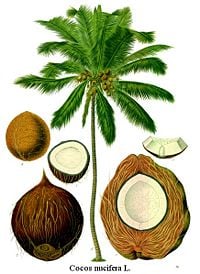 Coconut Palm (Cocos nucifera)
| ||||||||||||||
|
Secure
| ||||||||||||||
| Scientific classification | ||||||||||||||
| ||||||||||||||
| Cocos nucifera L. |
- For other uses, see Coconut (disambiguation).
The Coconut Palm (Cocos nucifera) is a member of the Family Arecaceae (palm family). It is the only species in the genus Cocos, and is a large palm, growing to 30 m tall, with pinnate leaves 4-6 m long, pinnae 60-90 cm long; old leaves break away cleanly leaving the trunk smooth. The term coconut refers to the fruit of the coconut palm.
The coconut palm is grown throughout the tropical world, for decoration as well as for its many culinary and non-culinary uses; virtually every part of the coconut palm has some human use.
Origins and cultivation
The origins of this plant are the subject of controversy, with some authorities claiming it is native to south Asia, while others claim its origin is in northwestern South America. Fossil records from New Zealand indicate that small, coconut-like plants grew there as long as 15 million years ago. Even older fossils have been uncovered in Rajasthan, TamilNadu, Kerala and Maharashtra, India. Regardless of its origin, the coconut has spread across much of the tropics, probably aided in many cases by sea-faring peoples. The fruit is light and buoyant and presumably spread significant distances by marine currents. Fruits collected from the sea as far north as Norway have been found to be viable (and subsequently germinated under the right conditions). In the Hawaiian Islands, the coconut is regarded as a Polynesian introduction, first brought to the islands by early Polynesian voyagers from their homelands in the South Pacific. They are now ubiquitous to most of the planet between 26ºN and 26ºS. The coconut palm thrives on sandy soils and is highly tolerant of salinity. It prefers areas with abundant sunlight and regular rainfall (750 to 2,000 mm annually), which makes colonizing shorelines of the tropics relatively straightforward. Coconuts also need high humidity (70–80%+) for optimum growth, which is why they are rarely seen in areas with low humidity (e.g. the Mediterranean), even where temperatures are high enough (regularly above 24°C). They are very hard to establish in dry climates and cannot grow there without frequent irrigation. They may grow but not fruit properly in areas where there is not sufficient warmth, like Bermuda.
Coconut palms are intolerant of freezing weather. They will show leaf injury below 34ºF (1ºC), defoliate at 30ºF (-1ºC) and die at 27ºF (-3ºC). There are rare reports of coconut palms surviving (with severe damage) to 20ºF (-7ºC). One night of freezing weather can set the growth of a coconut palm back about 6 months.
The flowers of the coconut palm are polygamomonoecious, with both male and female flowers in the same inflorescence. Flowering occurs continuously, with female flowers producing seeds. Coconut palms are believed to be largely cross-pollinated, although some dwarf varieties are self-pollinating.
Growing in the United States
The only two states in the U.S. where coconut palms can be grown and reproduce outdoors without irrigation are Hawaii and Florida. Coconut palms will grow from Bradenton southwards on Florida's west coast and Melbourne southwards on Florida's east coast. The occasional coconut palm is seen north of these areas in favored microclimates in the Tampa-St. Petersburg-Clearwater metro area and around Cape Canaveral. They may likewise be grown in favored microclimates on the barrier islands near the Brownsville, Texas area. They may reach fruiting maturity, but are damaged or killed by the occasional winter freezes in these areas. While coconut palms flourish in south Florida, unusually bitter cold snaps can kill or injure coconut palms there as well. Only the Florida Keys provide a safe haven from the cold as far as growing coconut palms on the U.S. mainland.
The farthest north in the United States a coconut palm has been known to grow outdoors is in Newport Beach, California along the Pacific Coast Highway. In order for coconut palms to survive in Southern California they need sandy soil and minimal water in the winter to prevent root rot, and would benefit from root heating coils.
Pests and diseases
Coconuts are susceptible to the phytoplasma disease lethal yellowing. One recently selected cultivar, 'Maypan', has been bred for resistance to this disease. The fruit may also be damaged by eriophyid mites.
The coconut is also used as a food plant by the larvae of many Lepidoptera species, including the following Batrachedra spp: B. arenosella, B. atriloqua (feeds exclusively on Cocos nucifera), B. mathesoni (feeds exclusively on Cocos nucifera), and B. nuciferae.
The fruit
| Coconut, meat, raw Nutritional value per 100 g | ||||||||||||||||||||||||||||||||||
|---|---|---|---|---|---|---|---|---|---|---|---|---|---|---|---|---|---|---|---|---|---|---|---|---|---|---|---|---|---|---|---|---|---|---|
| Energy 350 kcal 1480 kJ | ||||||||||||||||||||||||||||||||||
| ||||||||||||||||||||||||||||||||||
| Percentages are relative to US recommendations for adults. Source: USDA Nutrient database | ||||||||||||||||||||||||||||||||||
Botanically, a coconut is a simple dry fruit known as a fibrous drupe (not a true nut). The husk (mesocarp) is composed of fibers called coir and there is an inner "stone" (the endocarp). This hard endocarp (the outside of the coconut as sold in the shops of non-tropical countries) has three germination pores that are clearly visible on the outside surface once the husk is removed. It is through one of these that the radicle emerges when the embryo germinates. Adhering to the inside wall of the endocarp is the testa, with a thick albuminous endosperm (the coconut "meat"), the white and fleshy edible part of the seed. The endosperm surrounds a hollow interior space, filled with air and often a liquid referred to as coconut water, not to be confused with coconut milk. Coconut milk is made by grating the endosperm and mixing it with (warm) water. The resulting thick, white liquid is used in much Asian cooking, for example, in curries. Coconut water from the unripe coconut, on the other hand, is drunk fresh as a refreshing drink.
When viewed on end, the endocarp and germination pores gives to the fruit the appearance of a coco (also Côca), a Portuguese word for a scary witch from Portuguese folklore, that used to be represented as a carved vegetable lantern, hence the name of the fruit.[1] The specific name nucifera is Latin for nut-bearing.
When the coconut is still green, the endosperm inside is thin and tender, often eaten as a snack. But the main reason to pick the nut at this stage is to drink its water; a big nut contains up to one liter. When the nut has ripened and the outer husk has turned brown, a few months later, it will fall from the palm of its own accord. At that time the endosperm has thickened and hardened, while the coconut water has become somewhat bitter.
When the nut is still green the husk is very hard, but green nuts rarely fall, only when they have been attacked by moulds, etc. By the time the nut naturally falls, the husk has become brown, the coir has become dryer and softer, and the nut is less likely to cause damage when it drops. Still, there have been instances of coconuts falling from palms and injuring people, and claims of some fatalities. This was the subject of a paper published in 1984 that won the Ig Nobel Prize in 2001. Falling coconut deaths are often used as a comparison to shark attacks; the claim is often made that a person is more likely to be killed by a falling coconut than by a shark. However, there is no evidence of people being killed in this manner.[2] However William Wyatt Gill, an early LMS missionary on Mangaia recorded a story in which Kaiara, the concubine of King Tetui, was killed by a falling green nut. The offending palm was immediately cut down. This was around 1777, the time of Captain Cook's visit.
In some parts of the world, trained pig-tailed macaques are used to harvest coconuts. Training schools for pig-tailed macaques still exist in southern Thailand and in the Malaysian state of Kelantan. Competitions are held each year to discover the fastest harvester.
Opening a coconut
To open a coconut, pierce the softest "eye" with a skewer and drain the water. Then strike the coconut against a hard surface (such as concrete or a kitchen surface). It should break open similarly to an egg, cracking in more than one place. However, quite a lot of force is required. An easier way is to drain the water, then wrap the coconut in a towel and hit it with a hammer.
A way to open a fresh coconut is to take a long, heavy, knife (such as a machete) and score a line across the middle of the coconut by repeatedly striking then rotating. The final stroke should be heavier than the previous to crack the coconut along the scored line.
Uses
Nearly all parts of the coconut palm are useful, and the palms have a comparatively high yield (up to 75 fruits per year); it therefore has significant economic value. The name for the coconut palm in Sanskrit is kalpa vriksha, which translates as "the tree which provides all the necessities of life". In Malay, the coconut is known as pokok seribu guna, "the tree of a thousand uses". In the Philippines, the coconut is commonly given the title "Tree of Life".
Uses of the various parts of the palm include:
Culinary
- The white, fleshy part of the seed is edible and used fresh or dried in cooking.
- The cavity is filled with coconut water which contains sugar, fibre, proteins, anti-oxidants, vitamins and minerals. Coconut water provides an isotonic electrolyte balance, and is a highly nutritious food source. It is used as a refreshing drink throughout the humid tropics. It can also be used to make the gelatinous dessert nata de coco. Mature fruits have significantly less liquid than young immature coconuts; barring spoilage, coconut water is sterile until opened.
- Sport fruits are also harvested, primarily in the Philippines, where they are known as macapuno.
- Coconut milk is made by processing grated coconut with hot water or milk, which extracts the oil and aromatic compounds. It should not be confused with the coconut water discussed above, and has a fat content of approximately 17%. When refrigerated and left to set, coconut cream will rise to the top and separate out the milk.
- The leftover fibre from coconut milk production is used as livestock feed.
- The sap derived from incising the flower clusters of the coconut is fermented to produce palm wine, also known as "toddy" or, in the Philippines, tuba. The sap can also be reduced by boiling to create a sweet syrup or candy.
- Apical buds of adult plants are edible and are known as "palm-cabbage" (though harvest of these kills the palm).
- Ruku Raa is an extract from the young bud, a very rare type of nectar collected and used as morning break drink in the islands of Maldives reputated for its energetic power keeping the "raamen"(nectar collector) healthy and fit even over 80 and 90 years old. And by-products are sweet honey-like syrup and creamy sugar for desserts.
- The interior of the growing tip may be harvested as heart-of-palm and is considered a rare delicacy. Harvesting this also kills the tree. Hearts of palm are often eaten in salads, sometimes called "millionaire's salad".
- Newly germinated coconuts contain an edible fluff of marshmallow-like consistency called coconut sprout, produced as the endosperm nourishes the developing embryo.
Non-culinary
- Coconut water can be used as an intravenous fluid (see PMID 10674546).
- The water is also used in isotonic sports drinks.
- Coir (the fibre from the husk of the coconut) is used in ropes, mats, brushes, caulking boats and as stuffing fibre; it is also used extensively in horticulture for making potting compost.
- Copra is the dried meat of the seed and is the main source of coconut oil.
- The leaves provide materials for baskets and roofing thatch.
- Palmwood comes from the trunk and is increasingly being used as an ecologically-sound substitute for endangered hardwoods. It has several applications, particularly in furniture and specialized construction (notably in Manila's Coconut Palace).
- Hawaiians hollowed the trunk to form drums, containers, or even small canoes.
- The husk and shells can be used for fuel and are a good source of charcoal.
- Dried half coconut shells with husks are used to buff floors. In the Philippines, it is known as bunot.
- Shirt buttons can be carved out of dried coconut shell. Coconut buttons are often used for Hawaiian Aloha shirts.
- The stiff leaflet midribs can be used to make cooking skewers, kindling arrows, or are bound into bundles, brooms and brushes.
- The roots are used as a dye, a mouthwash, and a medicine for dysentery. A frayed-out piece of root can also be used as a toothbrush.
- Half coconut shells are used in theatre, banged together to create the sound effect of a horse's hoofbeats. They were used in this way in the Monty Python film Monty Python and the Holy Grail.
- The leaves can be woven to create effective roofing materials, or reed mats.
- Half coconut shells may be deployed as an improvised bra, especially for comedic effect or theatrical purposes. They were used in this way in the 1970s UK sitcom It Ain't Half Hot Mum for example.
- In fairgrounds, a "coconut shy" is a popular target practice game, and coconuts are commonly given as prizes.
- A coconut can be hollowed out and used as a home for a rodent or small bird. Halved, drained coconuts can also be hung up as bird feeders, and after the flesh has gone, can be filled with fat in winter to attract tits.
- A 1.5" hole can be made in a coconut and a banana placed inside. Secured to a tree, it makes a monkey trap.
- Fresh inner coconut husk can be rubbed on the lens of snorkelling goggles to prevent fogging during use.
- Dried coconut leaves can be burned to ash, which can be harvested for lime.
- Dried half coconut shells are used as the bodies of musical instruments, including the Chinese yehu and banhu, and the Vietnamese đàn gáo.
- Coconut is also commonly used as a herbal remedy in Pakistan to treat bites from rats.
- The "branches" (leaf petioles) are strong and flexible enough to make a switch. The use of coconut branches in corporal punishment was revived in the Gilbertese community on Choiseul in the Solomon islands in 2005.[3]
- Coconut seedlings are popular novelty houseplants.
- In World War II, coastwatcher scout Biuki Gasa was the first of two from the Solomon Islands to reach the shipwrecked, wounded, and exhausted crew of Motor Torpedo Boat PT-109 commanded by future U.S. president John F. Kennedy. Gasa suggested, for lack of paper, delivering by dugout canoe a message inscribed on a husked coconut shell. This coconut was later kept on the president's desk, and is now in the John F. Kennedy Library.
Cultural aspects
Coconuts are extensively used in Hindu religious rites. Coconuts are usually offered to the gods, and a coconut is smashed on the ground or on some object as part of an initiation or inauguration of building projects, facility, ship, etc.; this act signifies a sacrifice of ego, the idea that wealth stems from divinity, and the idea that, if due credit is not given, bad karma is taken on. In Hindu mythology it is referred as Kalpavruksha. In Hindu mythologies it is said that Kalapavruksha gives what is asked for.
- The Indonesian tale of Hainuwele tells a story of the introduction of coconuts to Seram.
- The people of the state of Kerala in southern India consider Kerala to be the "Land of Coconuts"; nalikerathinte naadu in the native language.
- The word "coconut" is also used as a mild derogatory slang word referring to a person of Latino, Filipino, or Indian subcontinent descent who emulates a white person (brown on the outside, white on the inside).
- "Coconut" is New Zealand slang for a Tongan, or other person of "Polynesian" descent, although usually not Maori.
- "Coconut" is also the title of a song by Harry Nilsson.
- "Coconut" is also the title of an In Reverie b-side track by Saves the Day.
- "Coconut" is also used as a slang term for breasts.
- Kid Creole's backing singers were known as his Coconuts.
- Cocolo originated as a term for a coconut seller.
- kurumba used as a term for coconut (Maldives).
ReferencesISBN links support NWE through referral fees
- ↑ Figueiredo, Cândido. Pequeno Dicionário da Lingua Portuguesa. Livraria Bertrand. Lisboa 1940. (in Portuguese)
- ↑ Are 150 people killed each year by falling coconuts? The Straight Dope, 19 July 2002. Retrieved 19 October 2006.
- ↑ Corporal punishment on the Solomon Islands
External links
- Coconut Research Center
- Coconut Research Institute of Sri Lanka
- Kokonut Pacific Developers of Direct Micro Expelling (DME) technology that enables Islanders to produce pure cold-pressed virgin coconut oil
- Coconut Festival
- Coconut Time Line
- Plant Cultures: botany, history and uses of the coconut
- Purdue University crop pages: Cocos nucifera
Credits
New World Encyclopedia writers and editors rewrote and completed the Wikipedia article in accordance with New World Encyclopedia standards. This article abides by terms of the Creative Commons CC-by-sa 3.0 License (CC-by-sa), which may be used and disseminated with proper attribution. Credit is due under the terms of this license that can reference both the New World Encyclopedia contributors and the selfless volunteer contributors of the Wikimedia Foundation. To cite this article click here for a list of acceptable citing formats.The history of earlier contributions by wikipedians is accessible to researchers here:
The history of this article since it was imported to New World Encyclopedia:
Note: Some restrictions may apply to use of individual images which are separately licensed.
